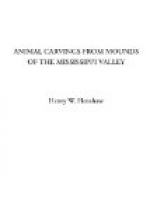OTHER ERRORS OF IDENTIFICATION.
[Illustration: Fig. 20.—“Owl,” from Squier and Davis.]
The erroneous identification of the manatee, the toucan, and of several other animals having been pointed out, it may be well to glance at certain others of the sculptured animal forms, the identification of which by Squier and Davis has passed without dispute, with a view to determining how far the accuracy of these authors in this particular line is to be trusted, and how successful they have been in interpreting the much lauded “fidelity to nature” of the mound sculptures.
Fig. 20 (Squier and Davis, Ancient Monuments of the Mississippi Valley, p. 225, Fig. 123) represents a tube of steatite, upon which is carved, as is stated, “in high relief this figure of an owl, attached with its back to the tube.” This carving, the authors state, is “remarkably bold and spirited, and represents the bird with its claws contracted and drawn up, and head and beak elevated as if in an attitude of defense and defiance.”
[Illustration: Fig. 21.—“Grouse,” from Squier and Davis.]
This carving differs markedly from any of the avian sculptures, and probably was not intended to represent a bird at all. The absence of feather etchings and the peculiar shape of the wing are especially noticeable. It more nearly resembles, if it can be said to resemble anything, a bat, with the features very much distorted.
Fig. 21 (Fig. 170 from Squier and Davis) it is stated, “will readily be recognized as intended to represent the head of the grouse.”
The cere and plainly notched bill of this carving clearly indicate a hawk, of what species it would be impossible to say.
[Illustration: Fig. 22.—“Turkey Buzzard,” from Squier and Davis.]
Fig. 22 (Fig. 171 from Squier and Davis) was, it is said, “probably intended to represent a turkey buzzard.” If so, the suggestion is a very vague one. The notches cut in the mandibles, as in the case of the carving of the wood duck (Fig. 168, Ancient Monuments), are perhaps meant for serrations, of which there is no trace in the bill of the buzzard. As suggested by Mr. Ridgway, it is perhaps nearer the cormorant than anything else, although not executed with the detail necessary for its satisfactory recognition.
[Illustration: Fig. 23.—“Cherry-bird,” from Squier and Davis.]
Fig. 23 (Fig. 173 from Squier and Davis) it is claimed “much resembles the tufted cherry-bird,” which is by no means the case, as the bill bears witness. It may pass, however, as a badly executed likeness of the tufted cardinal grosbeak or red-bird. The same is true of Figs. 174 and 175, which are also said to be “cherry-birds.”
Fig. 24 (Fig. 179 from Squier and Davis), of which Squier and Davis say it is uncertain what bird it is intended to represent, is an unmistakable likeness of a woodpecker, and is one of the best executed of the series of bird carvings. To undertake to name the species would be the merest guess-work.




